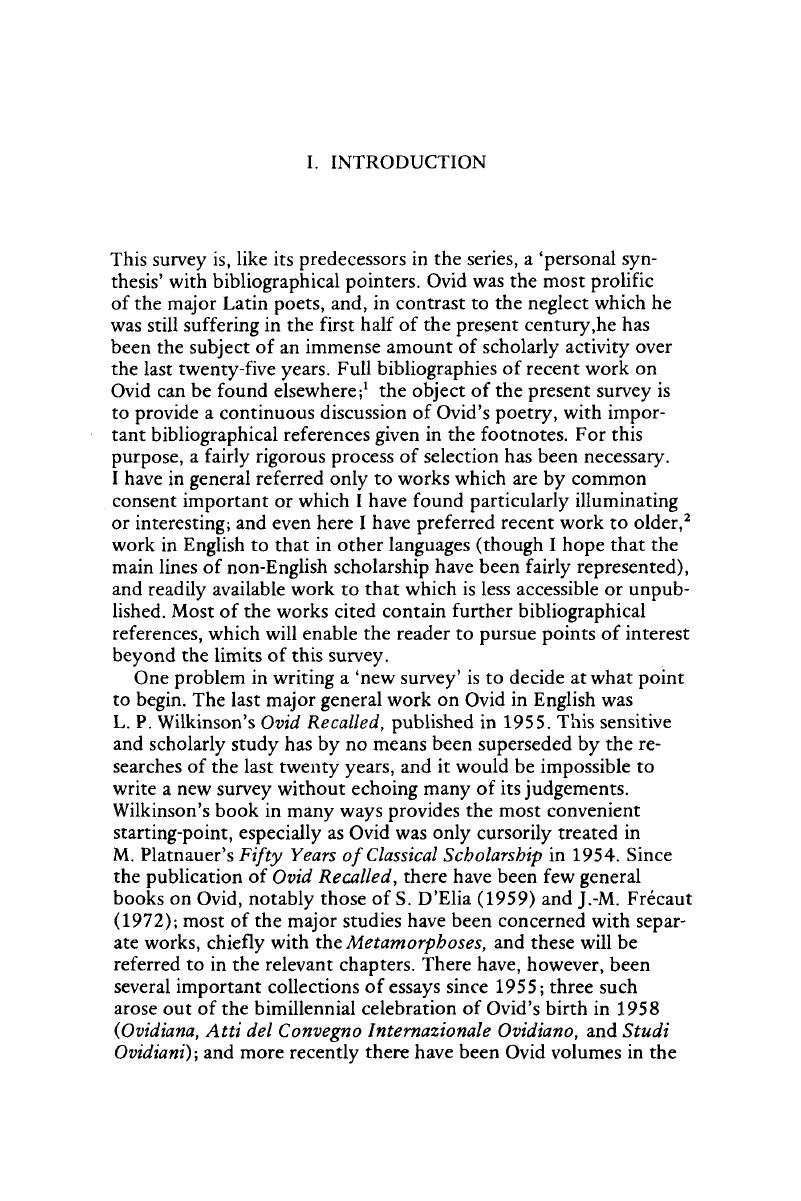No CrossRef data available.
Article contents
I. Introduction
Published online by Cambridge University Press: 05 February 2016
Abstract

- Type
- Introduction
- Information
- Copyright
- Copyright © The Classical Association 1978
References
Notes
(For works cited by author’s name or brief title only, see Appendix)
1. Apart from the annual reports in APb, see Kraus, W., AAHG 11 (1958), 129-46Google Scholar; 16 (1963), 1-14; 18 (1965), 193-208; and Albrecht, M. von, AAHG 25 (1972), 55–76 Google Scholar, 267-90; 26 (1973), 129-50. There is a briefly annotated bibliography in English for 1958-68 by Gariepy, R. J., CW 64 (1970), 37–56 Google Scholar.
2. For the older material see Martini, E., Einleitung zu Ovid (Prague, 1933 Google Scholar; repr. Darmstadt, 1970). Kraus’s RE article (reprinted in Wege zu Ovid) remains fundamental. Other older discussions still worth reading include those of Rand and (especially) Fränkel.
3. On matters of biography see Wheeler, A. L., AJPh 46 (1925), 1–28 Google Scholar, and Kraus (1), 67 ff.
4. This is an immense subject, of which Wilkinson’s two chapters (366 ff., 399 ff.) remain the best general discussion. C. Jameson, in Binns, Ovid, 210 ff., gives an interesting account of Ovid in the sixteenth century. Stroh, W., Ovid im Urteil der Nachwelt (Darmstadt, 1969)Google Scholar, provides an entertaining collection of verdicts on Ovid from Velleius to Pound, as well as a full bibliography for Ovid’s Nachleben since 1935.
5. There are recent editions of the Ibis by A. La Penna (Florence, 1957) and J. André (Paris, 1963), and of the Haliéutica by J. A. Richmond (London, 1962), F. Capponi (Leiden, 1972), and E. de Saint Denis (Paris, 1975). The Ibis can confidently be said to be Ovidian, but not the Halieutica, on which see Richmond, J. A., Hermes 96 (1968), 341-55Google Scholar, and Philologus 120 (1976), 92-106, or the Nux, on which see A. G. Lee, Ovidiana, 457-71.
6. On questions of style and literary allusion several of the older works (some recently reprinted) are still very useful. See esp. Washietl, Owen, and Wilkins on similes; Linse and Axelson on vocabulary; Zingerle, Lüneburg, and Ganzenmüller on imitation and allusion; Port on book-structure; and Plamauer on versification. The Concordance of Ovid by Deferrari, R. J., Barry, I., and McGuire, R. P. (Washington, 1939 Google Scholar; repr. Hildesheim, 1968) is indispensable for any study of Ovid’s usage.
7. For a thorough discussion see Jacobson, 300 ff. On the first edition of Am. see also Cameron, A., CQ 18 (1968), 320-33CrossRefGoogle Scholar.
8. See Fränkel, 143 and n., whose general view is still widely accepted, if not his precise dating of Fast, to A.D. 7-8. But Otis (2), 22, and Stössl, 22, may well be right to believe that Fast, was at least conceived and begun before Met. Ovid’s claim that it was the exile that interrupted Fast. (Tr. 2. 552) need not be taken at face value.
9. In his forthcoming book History in Ovid Syme places the first edition of Ars in c 8 B.C. (cf. D’Elia, 188, n. 110), and also argues that Fast, was broken off in A.D. 4 (I am grateful to Sir Ronald for conveying to me the essence of his views).


